Hovězí guláš (beef stew or goulash) is undoubtedly one of the famous Czech foods everybody should try when visiting the Czech Republic. Slow-braised and seasoned right, this goulash is characterized by rich and hearty color, aromatic flavor, and insanely delicious taste.
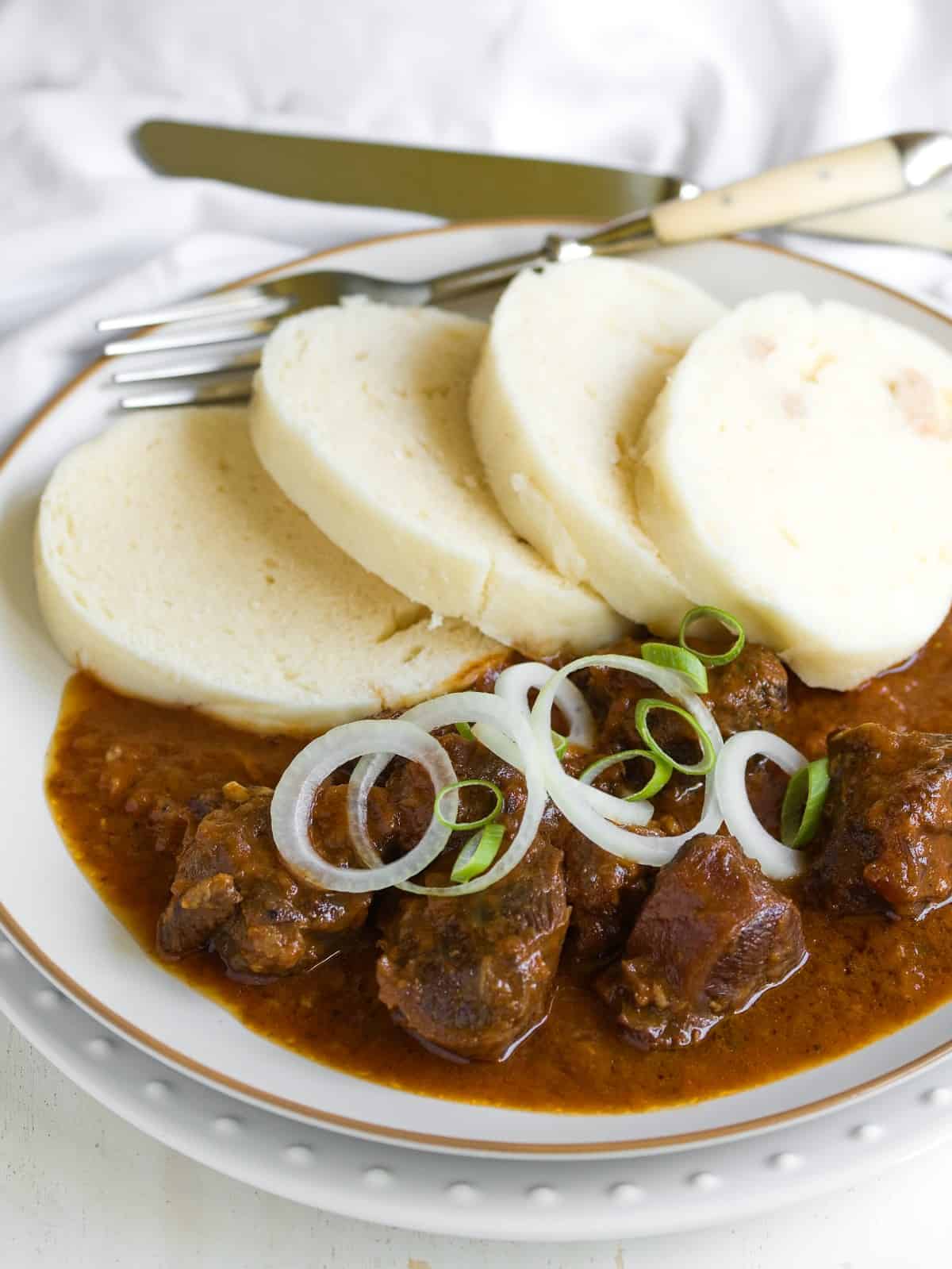
➜ What is Czech goulash
Czech beef goulash comprises big chunks of beef meat in a thick onion-based gravy. It’s served with bread dumplings or fresh bread garnished with onions and a piece of green parsley or other greens.
Together with Svickova or Rajska tomato sauce, the goulash is a staple of Czech cuisine.
There are many goulash recipe varieties all around central Europe: Hungarian, German, or Slovak. Each country uses a few different ingredients. I learned this traditional Czechoslovakian goulash recipe from my parents when Czechs and Slovaks lived in one country.
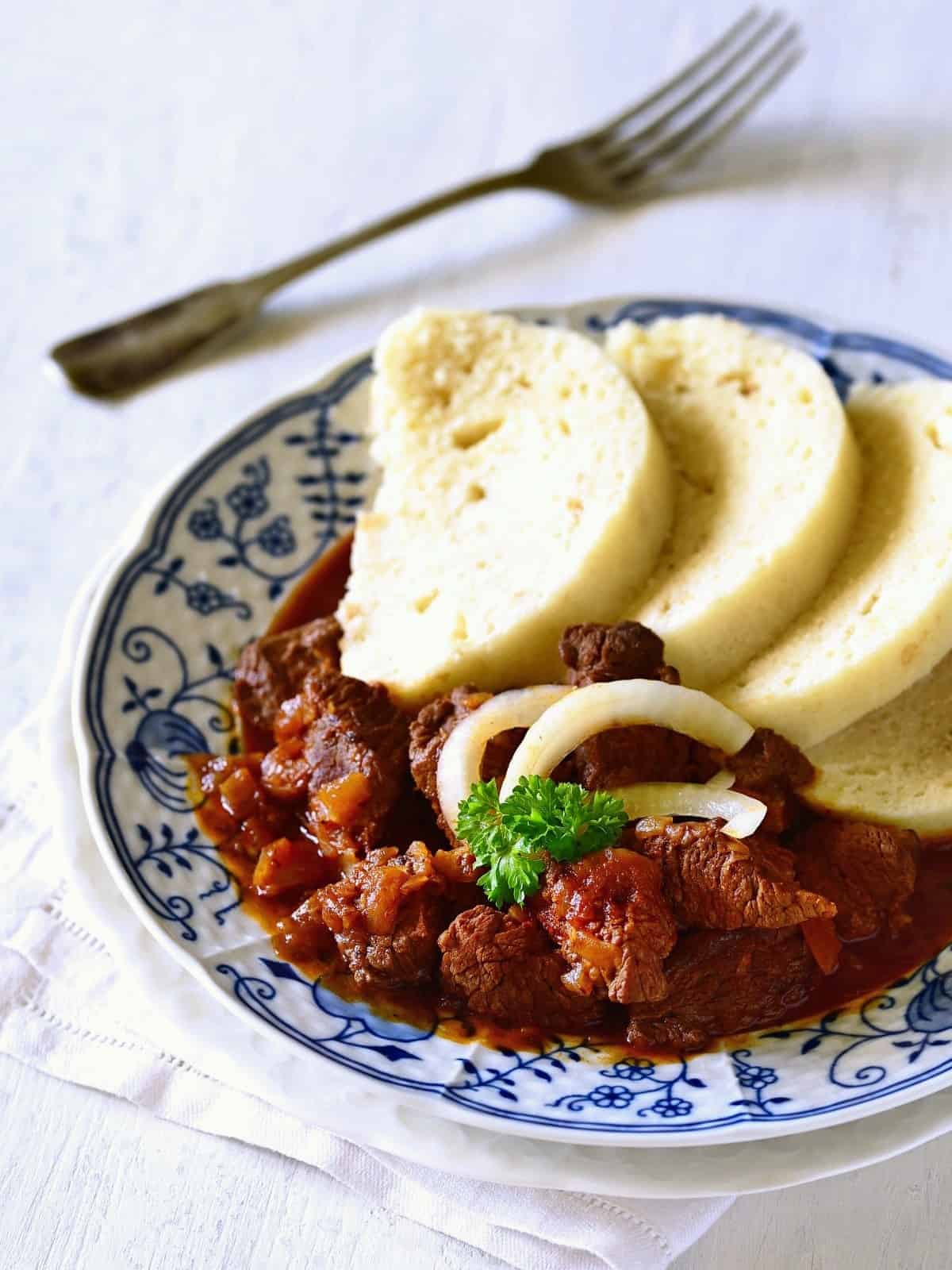
➜ Pronunciation
I recorded a short audio clip on how to pronounce the Czech word guláš (I’m a native Czech). The first word in the clip is "guláš", and the second is "hovězí guláš", which means beef goulash.
➜ Ingredients
Essential ingredients for great goulash are onions and meat in almost the same ratio, then typical Czech spices—dried marjoram and caraway seeds—and, of course, slow cooking!
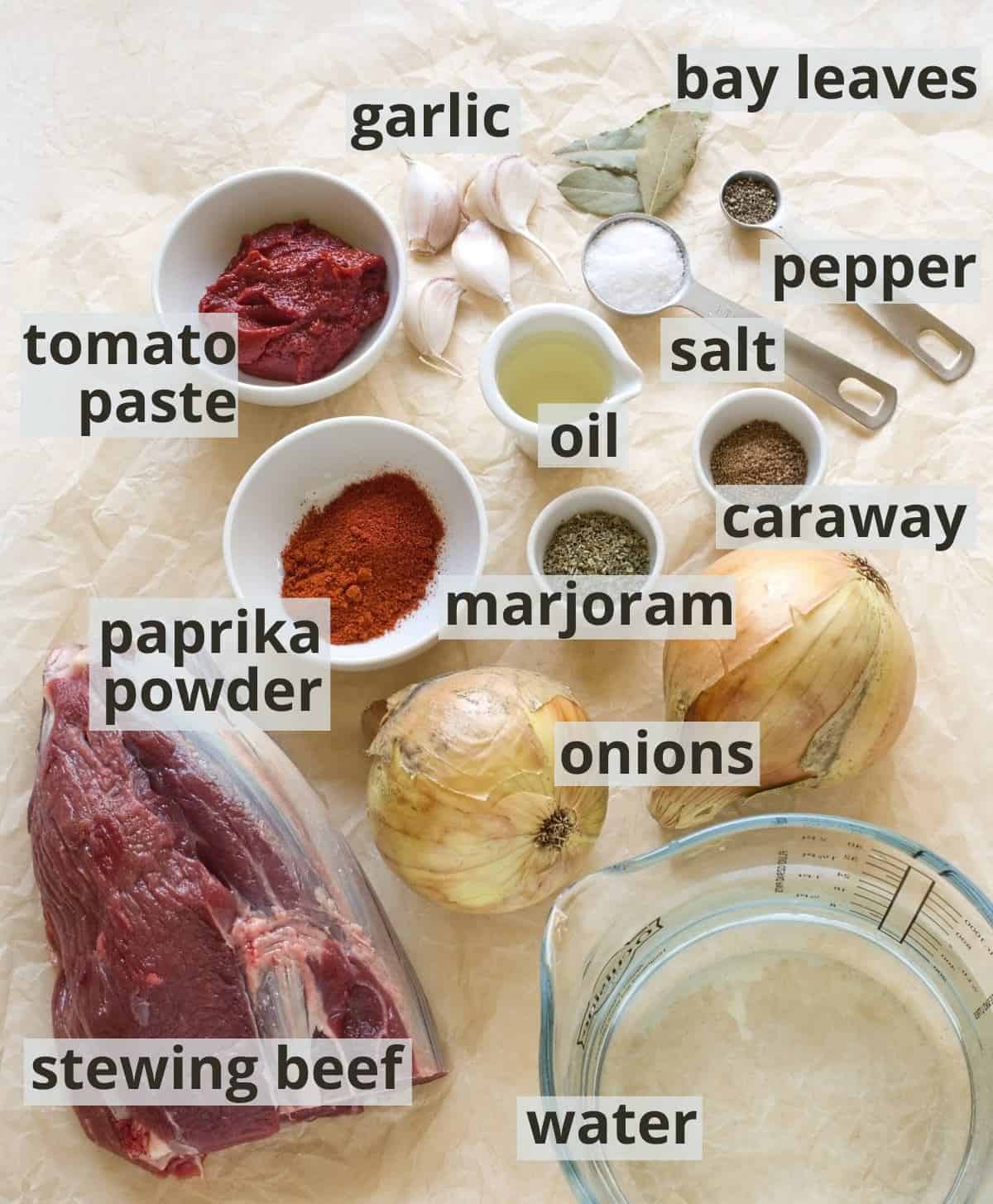
To make Czech goulash, you’ll need:
- Stewing beef; boneless beef chuck or beef shank, well-marbled, cut into 1-1.1/2 inch cubes
- Yellow onion; coarsely chopped, you will need almost as much onion as the beef weighs
- Pork lard; or vegetable oil such as sunflower or Canola
- Caraway seeds; crushed or ground
- Salt
- Black pepper; ground
- Sweet Hungarian paprika; ground. I recommend adding a teaspoon of hot paprika powder for those who like a strong taste. The goulash gets a real kick with hot paprika!
- Tomato paste; do not use tomato passata or ketchup.
- Bay leaves
- Water; or beef broth for a richer flavor
- Dried marjoram
- Fresh garlic; pressed or crushed cloves
- All-purpose flour; to thicken the goulash. You can skip the flour because the stew contains a large amount of onions, which will soften through long, slow cooking and naturally thicken the goulash. On the other hand, I use only one tablespoon of flour for the recipe. I thicken the stew with flour with one nifty trick, which I'll reveal during the recipe. If you are based in the UK, use plain flour.
✅ You’ll find the exact amount of ingredients below in the recipe card, which you can also print out.
➜ Instructions
The most important rule is that a delicious goulash starts with thoroughly processing the ingredients at the very beginning. The onions, like the meat, have to be fried brown and seasoned in the proper order. Only then will the goulash be exactly what you expect—with a distinctive flavor and vibrant color.
STEP 1: Peel the onion and chop it roughly. Cut the beef into 1-1.1/2-inch pieces.
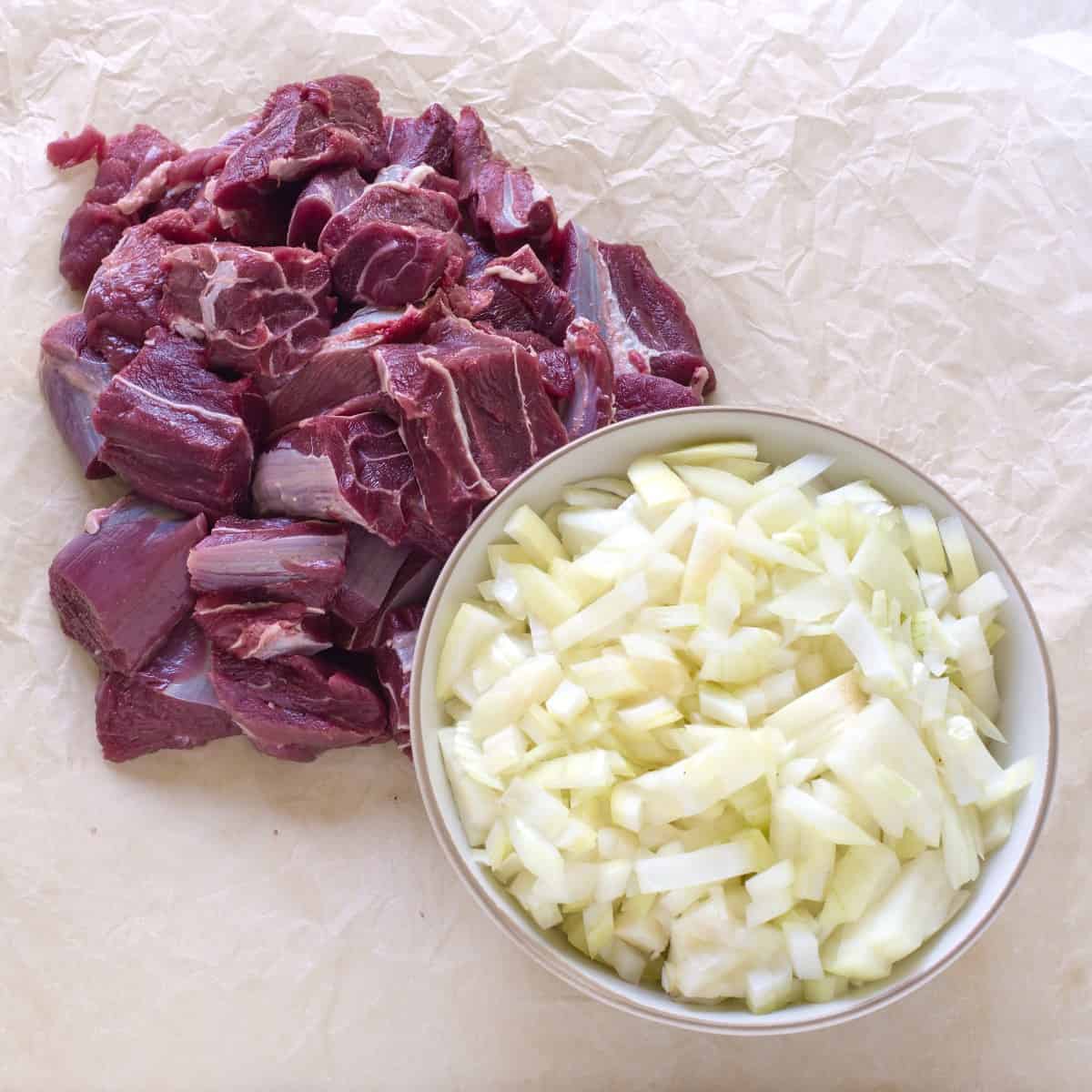
STEP 2: Melt the lard or vegetable oil over medium-high heat in a pot with a thick bottom (I use a heavy iron cast Dutch oven). Fry onions until almost brown. Stir frequently to avoid burning. Finally, add the crushed caraway seeds and stir for another minute.
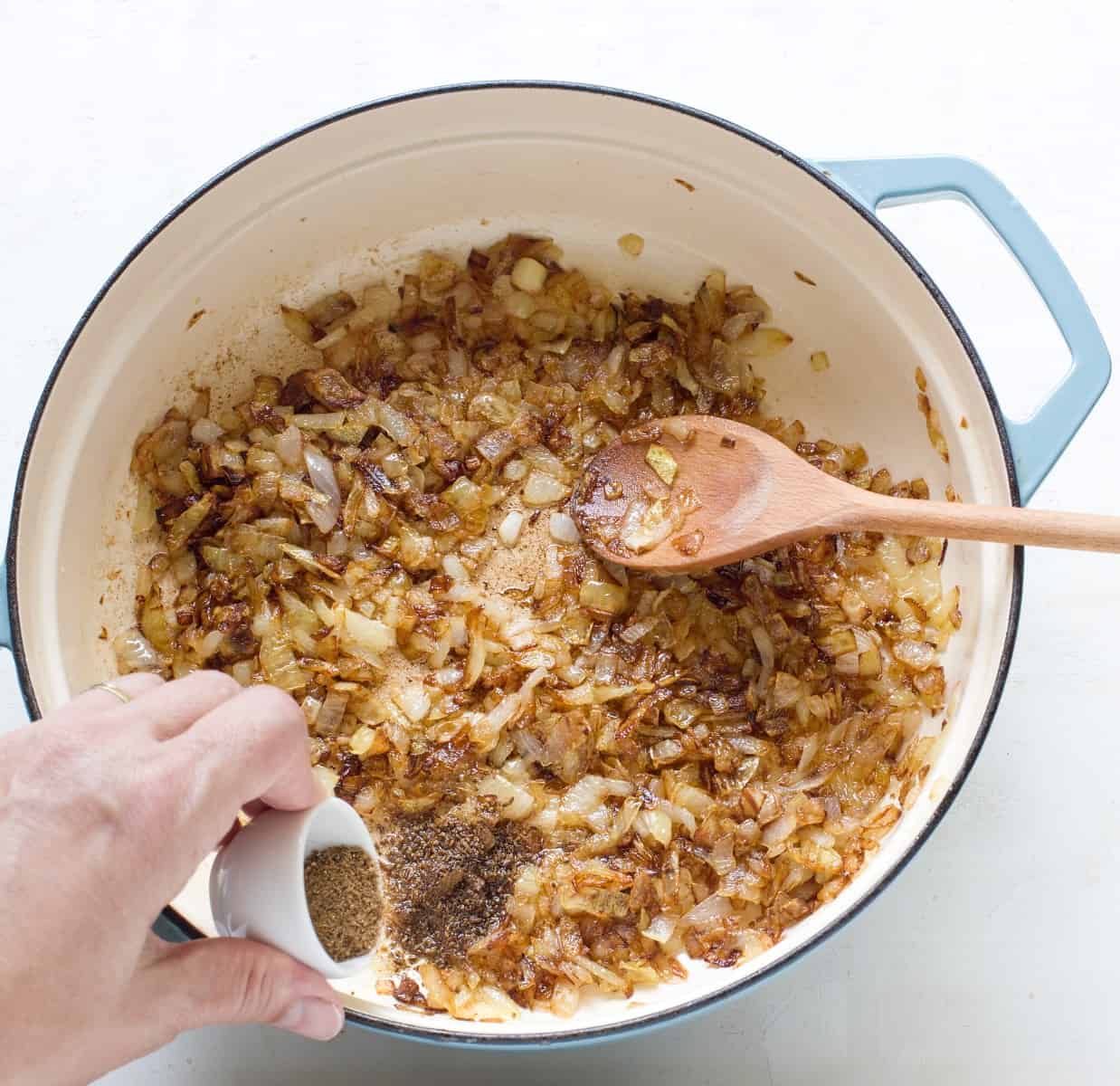
STEP 3: Add beef chunks, season with salt, and fry them from all sides until a golden brown crust is created. Expect the meat releases some juices when fried. Stir frequently, and scrape off the burnt residue on the bottom of the pot with a wooden spatula. If necessary, reduce the heat or add a spoon or two of water.
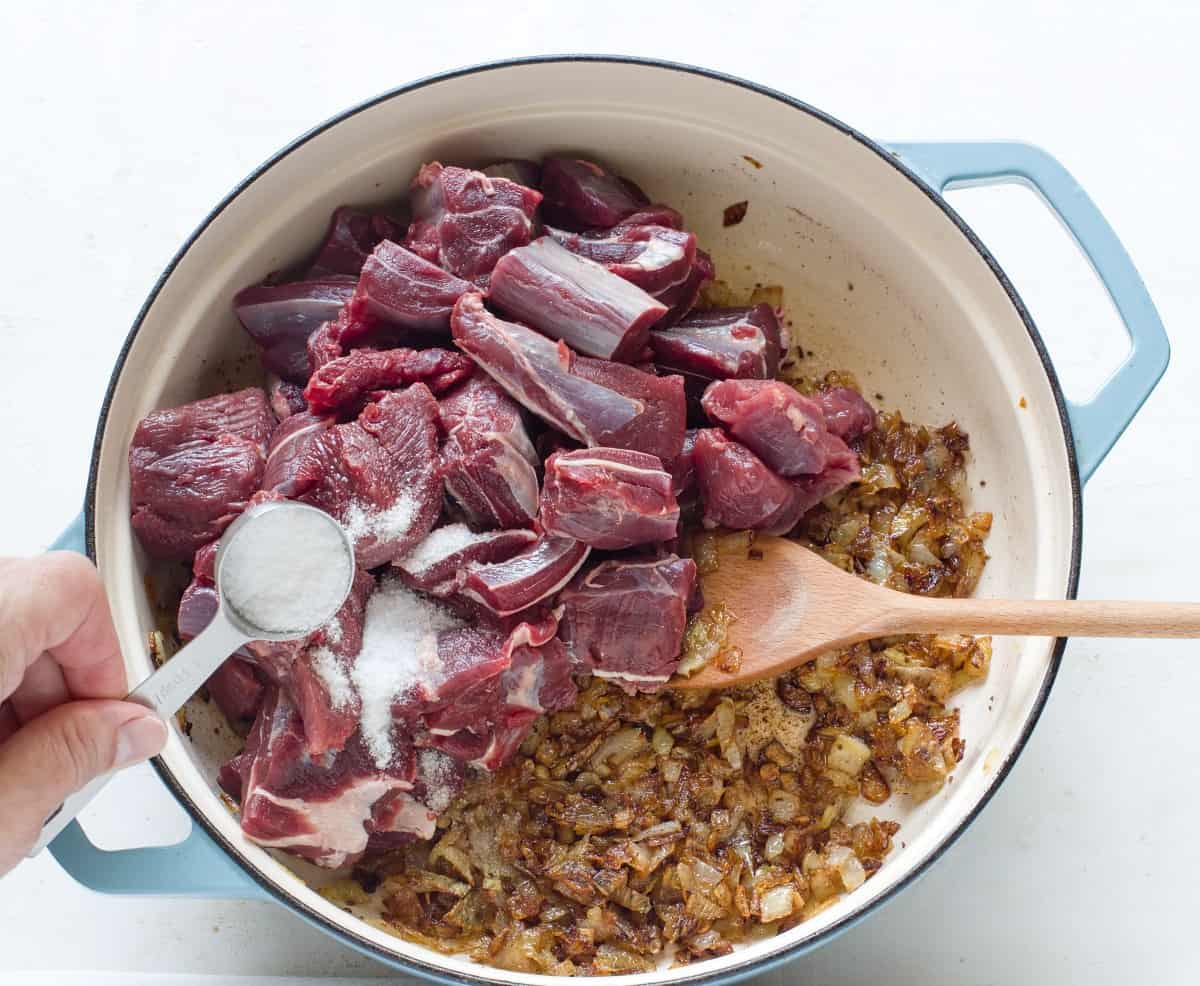
STEP 4: Turn the stove on medium heat, and add ground pepper, sweet paprika, and tomato paste. Fry for 1 minute while stirring. The base can’t get burnt, or else the goulash will taste bitter. Add 1-2 spoons of water to prevent burning.
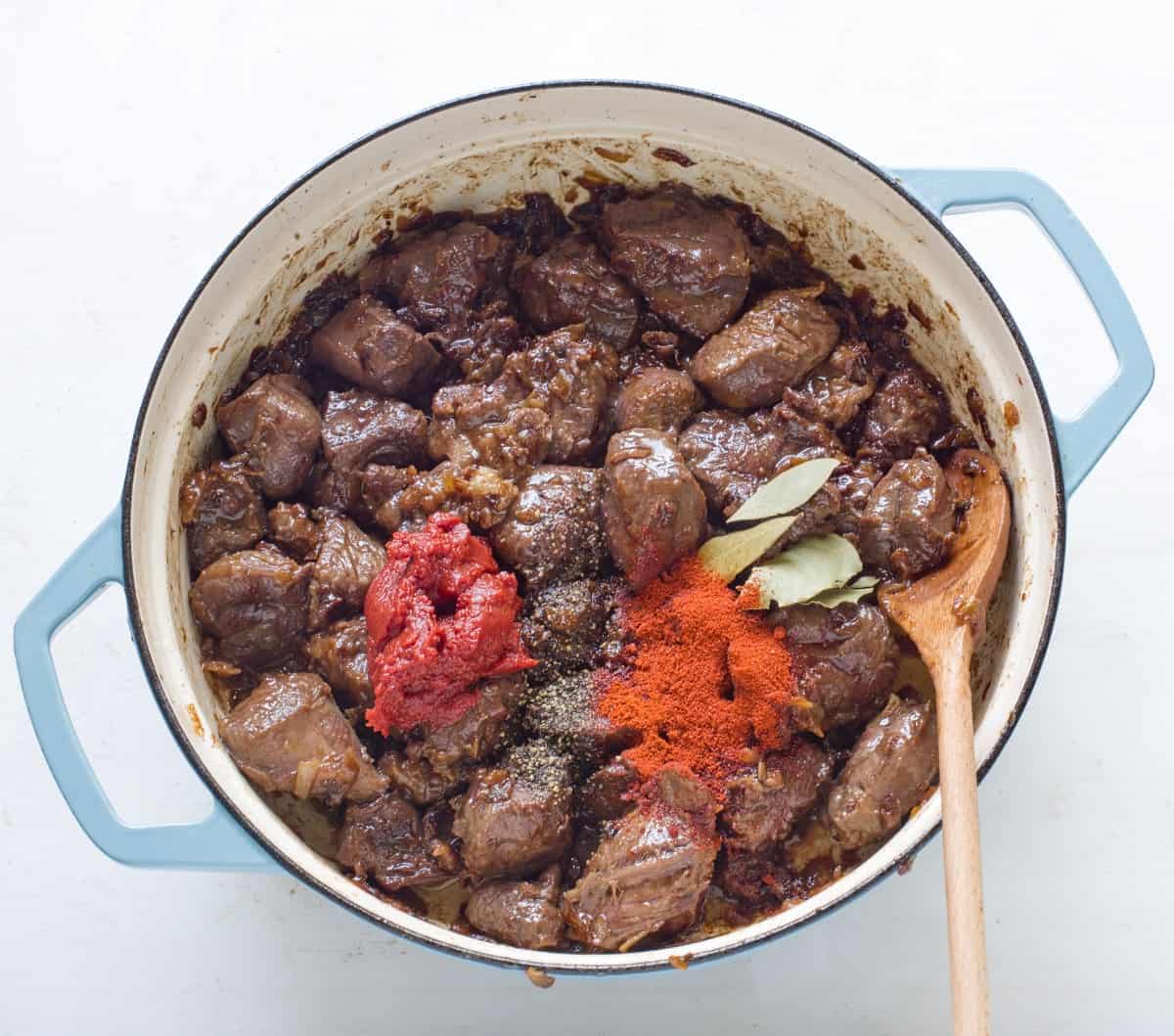
STEP 5: Pour in water so the meat is almost covered. Add bay leaves. Bring to a boil, reduce the heat to a minimum, cover with a lid and allow the beef to simmer for 2–2.5 hours or until soft.
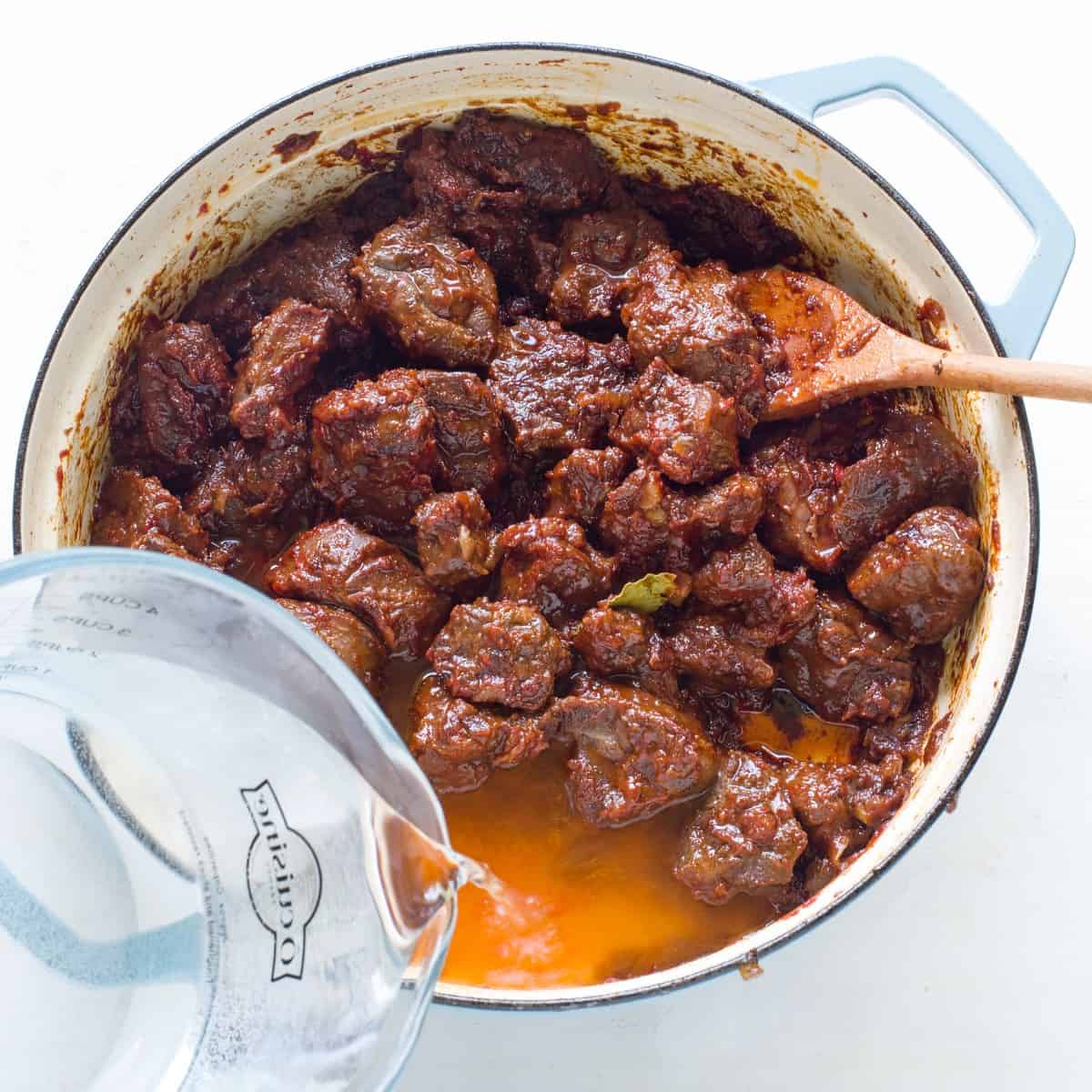
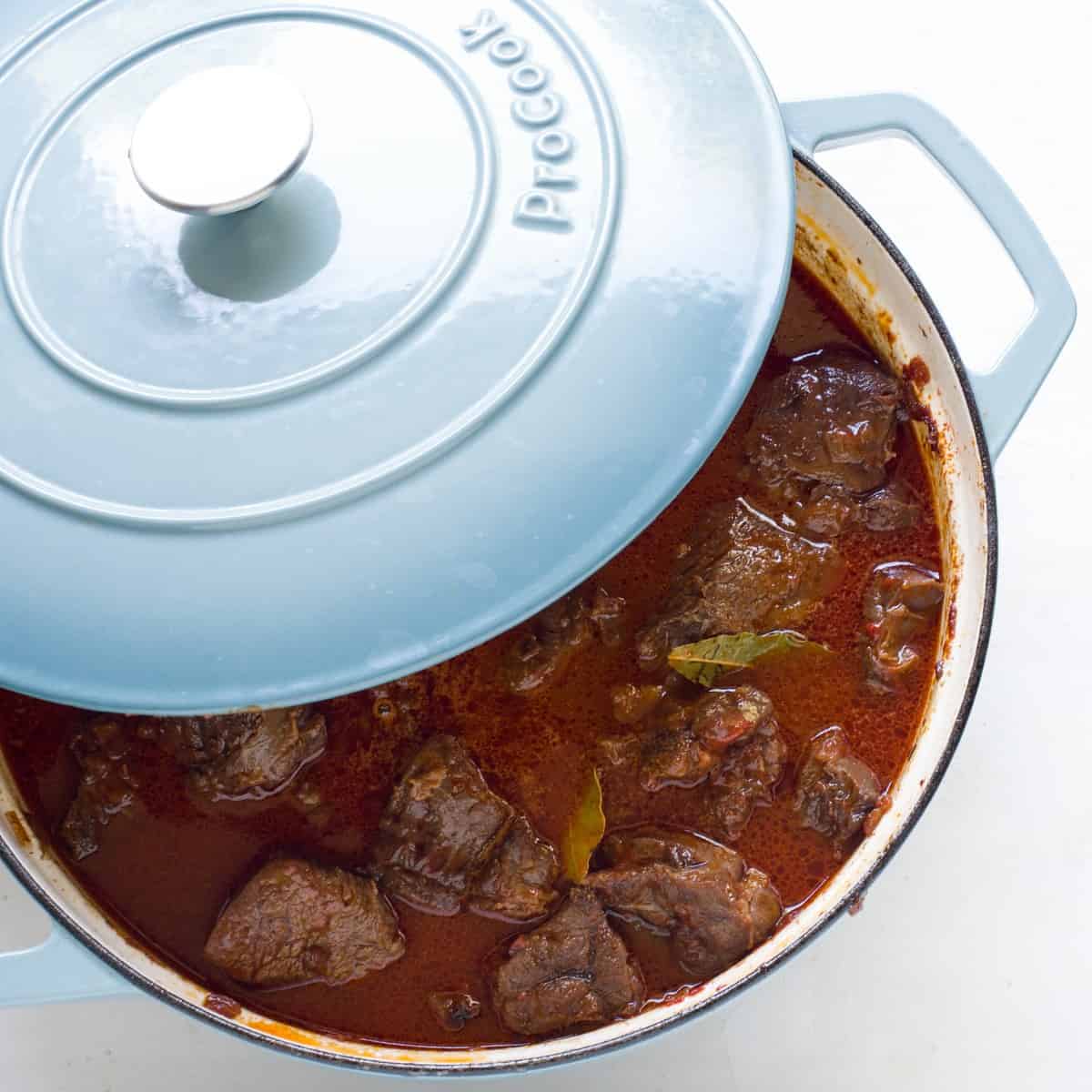
Check the goulash from time to time. Add some water if the level of liquid in the pot falls. When the gulas contains too much water, cook it uncovered at the end. The liquid will be reduced, and the gulas will gain a richer flavor and a nice red color. Stir occasionally.
STEP 6: When the beef cubes are soft, add flour to thicken the stew. I'll provide a helpful method for making the stew sauce smoother and more cohesive.
Take off the pot's lid. Using a small sieve, carefully dust the surface of the stew with a tablespoon of flour. Do not stir. Cover with the lid and leave to cook for a further 15 minutes. Remove the lid and stir. The sauce will be just thick enough!
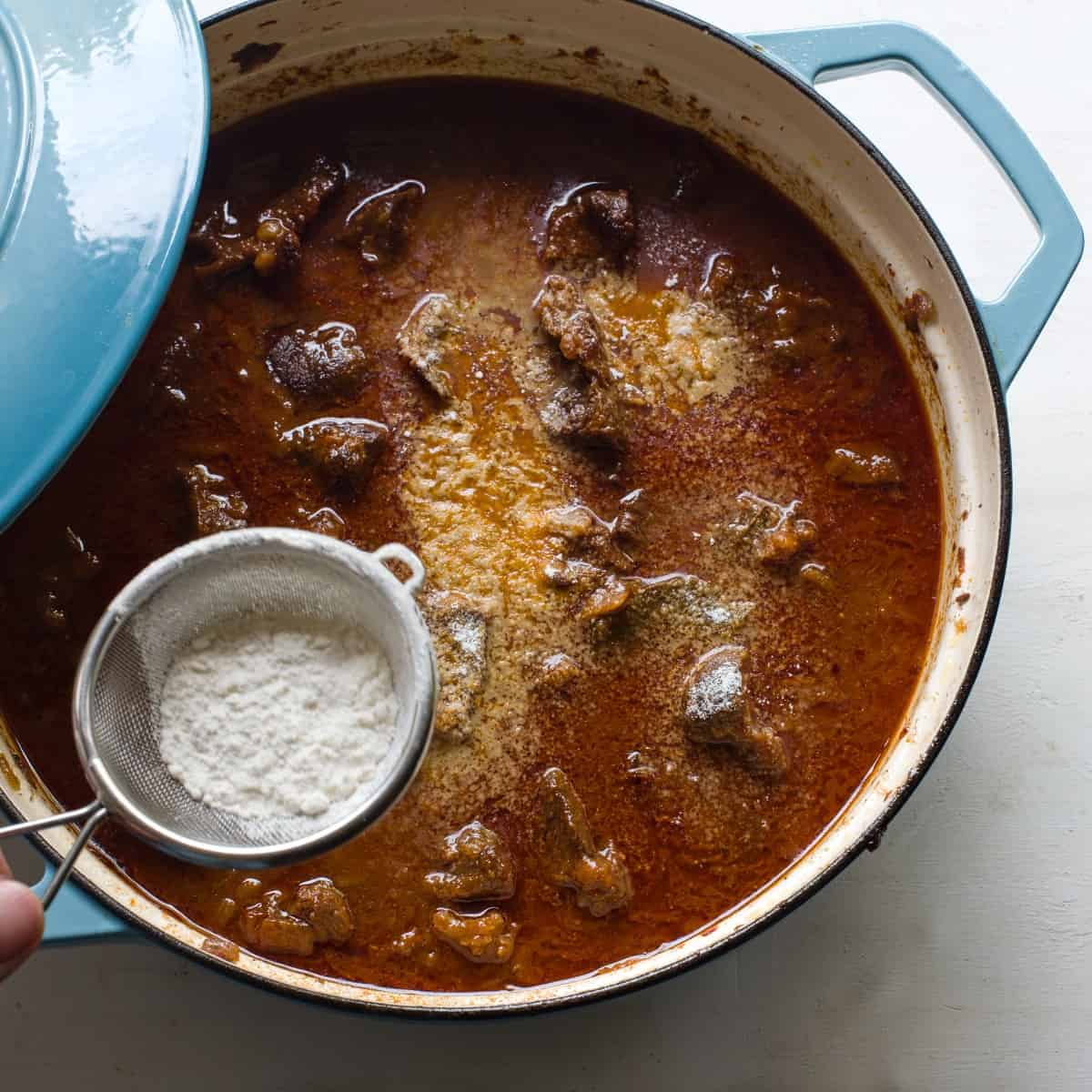
Good to know: feel free to skip this step, especially if you are sensitive to the gluten included in the flour.
STEP 7: Remove bay leaves, add crushed garlic and dried marjoram, and stir. Season with salt to your liking. Cover with a lid and let it rest off heat for 10 minutes.
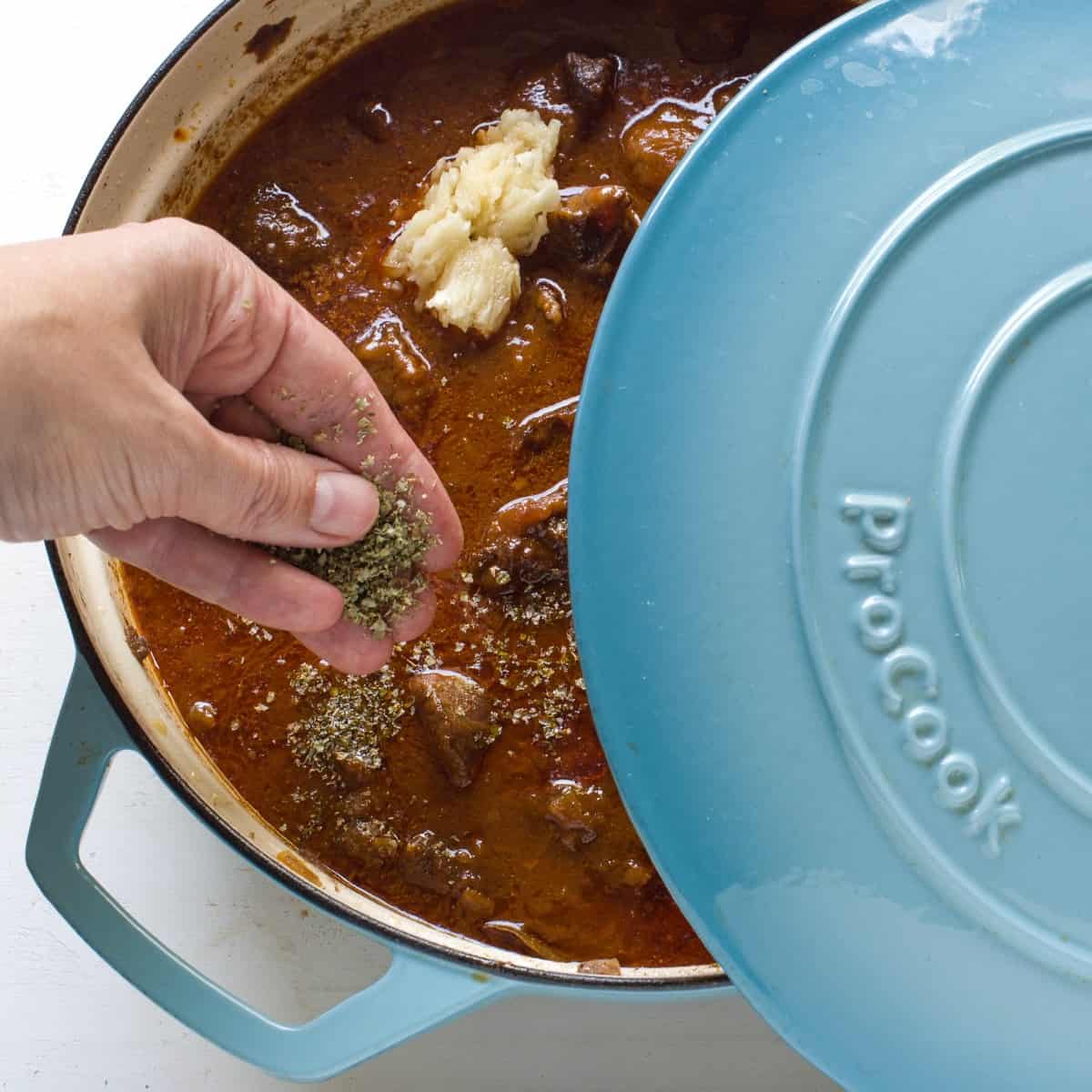
➜ Serving
Serve the goulash in a deep bowl with a piece of bread or warm slices of Czech dumplings (an iconic side dish!) arranged on the side of a plate. Top the dish with a few raw onion circles and sprinkle some green parsley for the final touch.
A less common side is pasta, typically elbow pasta (kolínka).
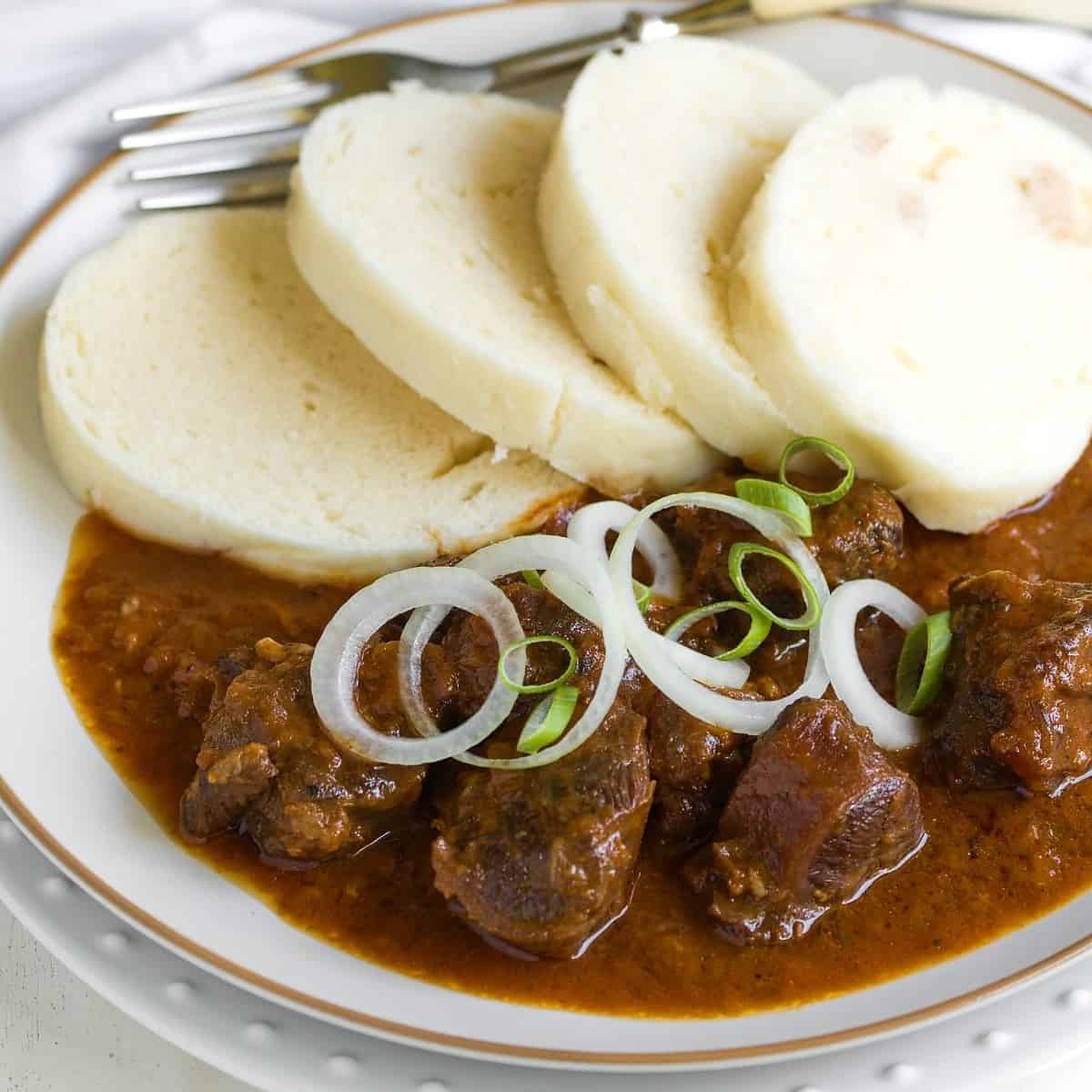
MY TIP: Once you visit Prague, the capital city of the Czech Republic, try to order “guláš se šesti” in a pub. Literally translated, it means “Goulash with six slices of dumplings.” This is a typical number of dumplings that bold Czechs are used to getting in a restaurant. And of course, don’t forget chilled Pilsner beer!
A fan of stews? Don’t miss this delicious Austrian goulash!
➜ How to store
If you have any leftover goulash, keep it in an airtight container in the fridge for about 4-5 days.
Reheat the stew slowly on the stove while stirring. If the sauce is too thick, add a tablespoon or two of water.
➜ Tips for the best goulash
- Add the marjoram to the goulash at the end of cooking, off heat.
- There is one unspoken secret: Czech goulash always tastes better the next day.
- Instead of water, cook the goulash with beef stock. The flavor of this lovely Czech meal will be even more decadent!
➜ FAQs
Cheaper cuts of beef such as beef chuck or shank (kližka) are the best for Czech goulash. The beef should be fat-marbled, else goulash will be dry.
Czech goulash is thickened with plenty of onions. Use almost as much onion as the beef weighs. Bohemian grandmas used to thicken goulash with bread, bread crumbs, or a little flour.
Slow simmering in a covered pot is necessary, and it takes about 2 hours until the beef is soft and tender.
More Czech dishes:
- Pork goulash
- Czech sausage goulash (burtgulas)
- Wiener Schnitzel – made with veal
- Šunkofleky – ham and noodle bake
- Braised beef cubes – slow simmered beef with garlic
- Beef roll ups – Spanelske ptacky roulades
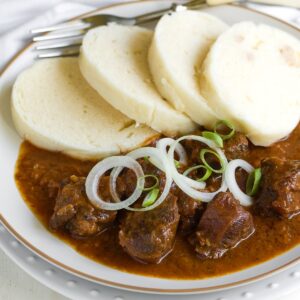
Czech Beef Goulash (Gulas)
Ingredients
- 2 pounds beef chuck or shank (900 g)
- 1.1/2 pounds onion (675 g)
- 4 Tablespoons vegetable oil sunflower or Canola / pork lard
- 2 Tablespoons tomato paste
- 1 teaspoon caraway seeds crushed or ground
- 2 Tablespoons sweet Hungarian paprika ground + optionally 1 tsp hot paprika powder
- 4 bay leaves
- 1 tsp dried marjoram
- 4 cloves garlic peeled, crushed
- ¼ teaspoon black pepper ground
- salt
- 1 Tablespoon all-purpose flour to thicken the goulash, optional
- 4 cups water (720 ml) or beef stock
Instructions
- Peel the onion and chop it roughly. Cut the beef into 1-1.½-inch pieces.
- Melt the lard or vegetable oil over medium-high heat in a pot with a thick bottom (I use a heavy iron cast Dutch oven). Fry onions until almost brown. Stir frequently to avoid burning. Finally, add the crushed caraway seeds and stir for another minute.
- Add beef chunks, season with salt, and fry them from all sides until a golden brown crust is created. Expect the meat releases some juices when fried. Stir frequently, and scrape off the burnt residue on the bottom of the pot with a wooden spatula. If necessary, reduce the heat or add a spoon or two of water.
- Turn the stove on medium heat, and add ground pepper, sweet paprika, and tomato paste. Fry for 1 minute while stirring. The base can’t get burnt, or else the goulash will taste bitter. Add 1-2 spoons of water to prevent burning.
- Pour in water, so the meat is almost covered. Add bay leaves. Bring to a boil, reduce the heat to a minimum, cover with a lid and allow the beef to simmer for 2–2.5 hours or until soft.
- Check the goulash from time to time. Add some water if the level of liquid in the pot falls. When the gulas contains too much water, cook it uncovered at the end. The liquid will be reduced, and the gulas will gain a richer flavor and a nice red color. Stir occasionally.
- When the beef cubes are soft, add flour to thicken the stew. In the next step, I'll provide a helpful method for making the stew sauce smoother and more cohesive.
- Thickening of goulash with flour (optional): Take off the pot's lid. Using a small sieve, carefully dust the surface of the stew with a tablespoon of flour. Do not stir. Cover with the lid and leave to cook for a further 15 minutes. Remove the lid and stir. The sauce will be just thick enough!
- Remove bay leaves, add crushed garlic and dried marjoram, and stir. Season with salt to your liking. Cover with a lid and let it rest off heat for 10 minutes.
Notes
- Makes 6 yields.
- SERVING: Serve the goulash in a deep bowl with a piece of bread or warm slices of Czech dumplings (an iconic side dish!) arranged on the side of a plate. Top the dish with a few raw onion circles and sprinkle some green parsley for the final touch. And of course, don’t forget chilled Pilsner beer!
- A less common side is pasta, typically elbow pasta (kolínka).
- Instead of water, cook the beef in beef stock, and the flavor of guláš will be even richer.
- There is one unspoken secret: Czech guláš always tastes better the next day!
- STORAGE: If you have any leftover goulash, keep it in an airtight container in the fridge for about 4-5 days.
- REHEATING: Reheat the stew slowly on the stove while stirring. If the sauce is too thick, add a tablespoon or two of water.
DISCLAIMER: Because I come from Central Europe, my recipes are based on metric units such as grams or milliliters. Check out how I convert metric units to the U.S. system:
Conversion chartNutritional Estimate pro portion
Note: This is an updated version of the goulash recipe that was originally published on 6/2021.


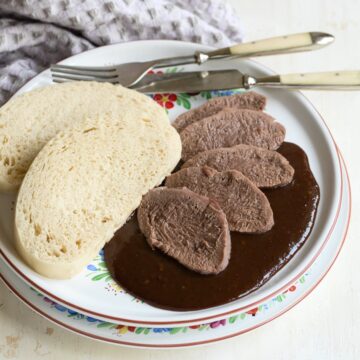
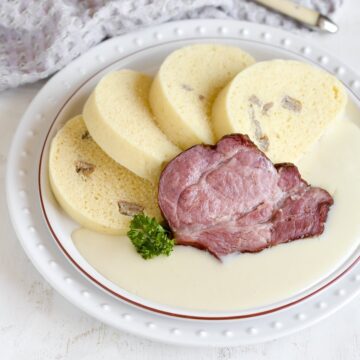
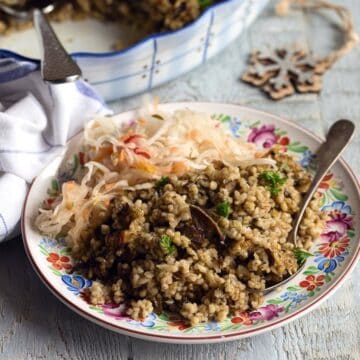
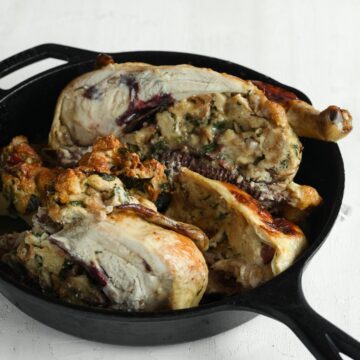
Taty
Jesus loves you!!
Vicky
I made this goulash recipe last night and it was fantastic! My boyfriend is Czech and he misses home cooking - he loved it! The only thing I changed was to add a bit of minced fresh garlic at the end with the marjoram.
I also used your recipe for knedliky, and together, they made a fantastic Czech dinner! Thank you for posting!
Petra Kupská
Ahoj Vicky, thank you for your message and nice feedback! Minced garlic is a perfect enhancement; I think it makes the goulash taste even more Czech 🙂 Right, goulash goes best with dumplings, and I'm glad you had success with this dish! Best wishes from Bohemia, Petra
Mark
just made this, i gave it a couple of tweeks to suit my taste, fantasric recipe, it reminds me if our trip to prague, dont want to cause an argument but czech goulash is better than hungarian.
David
We went to Prague last month. Made this for dinner tonight, and it took me right back! An excellent recipe, very well described, and the results were delicious. Thank you very much!
Petra Kupská
Thank you, David, for your nice comment! I hope you enjoyed your stay in Prague 🙂
Grace P
I made this goulash, your knedliky, and your apple carrot salad for my family's Christmas dinner, and all the recipes worked perfectly! They were very easy to follow and the pictures were really helpful. All of the dishes turned out exactly as they should have, even though I had never made any of them before. I'm excited to try more of your recipes, thank you for sharing them!
Petra Kupská
Ahoj Grace, thanks a lot for your lovely comment! I am glad to hear all the recipes turned out well and your family like them 🙂
Laura
Very good recipe and super quick & easy to make! First time to make a Czech goulash as my heritage is Czech and was very impressed with the flavors - added an additional two tsps of paprika to spice up the flavor a notch
Petra Kupská
Thanks a lot, and I’m glad the Czech goulash was a hit with your family! Adding quality paprika to a goulash is always a good idea 🙂 Best wishes, Petra
Gerardo
Hi, the recipe sounds delicious, I have a question: could I serve it with the potato dumplings instead of the bread ones?
Petra Kupská
Hi Gerardo,
Thank you for reaching out!
The Czech goulash is best suited to bread dumplings, they are fluffier than potato dumplings, which are denser. Potato dumplings go great with roast duck or goose, or with roasted pork and sautéed spinach.
Try it, though, you might like the combination of beef stew and potato dumplings!
Kristina
Your recipes bring back so many memories of my grandmother cooking for us in Australia, love goulash and dumplings she would also have make a side dish of cabbage with caraway seeds . Then for breakfast we would have the left over dumpling fried with eggs. YUM. Thank you
Petra Kupská
Thank you, Kristina, for your lovely comment. Just as you write, goulash with dumplings, and leftover dumplings then fried until golden brown for breakfast with eggs. Typically Czech!
Jitka J.
Oh, Kristina, you brought back a lovely memory. My grandpa used to make us fried leftover dumplings with eggs all the time. He called it opecany. Nowhere else have I seen or heard of this dish, and completely forgot about it. Thank you 🙂
Petra Kupská
Jitka, the word opecany could really translate as fried 🙂 Leftover dumplings with eggs, that is "knedlik s vajickem." My dad was a master at making this dish in our house too! 🙂 In case you would like the recipe: Czech dumplings with eggs
Barbara
Please give your recipe for the dumplings! Thank you.
Petra Kupská
Hi Barbara, here are the recipes for Czech dumplings:
Bread dumplings - made with yeast, perfect for goulash and Czech sauces
Potato dumplings - made with shredded boiled potatoes, excellent for poultry or braised beef with sautéed spinach, slow-cooked pork roast
Marketa
This looks interesting, I have never made goulash adding marjoram and raw garlic at the end, I will try it soon. Step 7 of the summarised recipe (bottom of this page) does not mention garlic, I think it has been accidentally not included.
Petra Kupská
Hi Marketa, thank you very much for your sharp eye. You're right; in the recipe, I forgot to include information about when to add garlic to the goulash, I have fixed it. Thank you once again!
Jitka J.
How long would you cook the beef in a pressure cooker (papinak) and would the results be just as good? Just trying to save some time 🙂
Thank you for your recipes<3
Petra Kupská
Ahoj Jitka, I totally understand the time-saving point! 🙂 I think the stew will be just as good as if you cooked it slowly. The beef goulash in the papinak pressure pot should take no more than 45 minutes to cook, depending on the size of the meat cubes. Fingers crossed that the goulash is a success!
Ruda Vodička
Ahoj Petro! Narodil jsem se v Českých Budějovicích, ale vyrůstal jsem v Kanadě. Mám maminčin český receptář Kuchařka Naše Vesnice, ale převést to do severoamerických kuchařských norem není ani přes mou plynulost češtiny rychlé ani snadné. Dnes používáme vaše recepty na guláš a knedlíky. Moje maminka vařila hodně českých jídel, ale maminka má teď Alzheimers a nemůže mi pomoct s českými recepty. Můj kanadská manželka a naše dvě malé děti jsou zaujati českým jídlem a kulturou, takže se propracováváme k receptům, hlavně díky vašemu webu a díky tomu, co mohu vyčíst z receptů od maminky. Děkujeme, že jste si našli čas a úsilí zpřístupnit české recepty anglicky mluvící veřejnosti. Vaše děti odvedly skvělou práci při překládání! Je vidět, že jste vzdělaná a kulturní rodina a my vám za to děkujeme.
Anicka Cooklikeczechs.com
Zdravim, Rudo! Moc Vam dekuji za mily komentar. Toho s Vasi maminkou je mi lito, ale je hezke, ze ceske pokrmy varite i s detmi nadale. At Vam stale chutna! 🙂
Petra G
Souhlasim s Rudou, nektere ingredience nejsou v zahranici k dispozici (napriklad hladka / hruba mouka) takze vysvetleni v anglictine a jake nahrazky jsou nejlepsi je super helpful! Petra na hrad!! 🙂
Anicka Cooklikeczechs.com
Velmi dekuji, Petro! 🙂
Alice
Hi, looks great!!! Can I prepare it all and then put it in the crockpot to cook slow?
Anicka Cooklikeczechs.com
Dear Alice, the crockpot is a great idea, but you must fry the meat and onions beforehand as I describe in the recipe. Then transfer to the crockpot, where the stew will simmer until tender. Good luck!
Mathys
Hello ! This looks delicious 🙂 do you know if I can replace water with beer for example ? I ate one in Prague and that was wonderful !
Laura
Thank you so much for your website! Our favorite Bohemian restaurant close a few years ago, & I've been looking for simular recipes ever since. Made your goulash last night & it was wonderful! Can't wait to try your Liver Dumpling Soup! It was a favorite!
Anicka Cooklikeczechs.com
Ahoj Laura, thank you for your comment and kind words! I am delighted to hear you like the recipes - hope the Liver Dumpling Soup will turn up to your expectations.
Greetings from the Czech Republic.
Joe DeWeese
I have made this recipe several times. Today the temperature dropped to-1°, so Gulas seemed a perfect choice.
Looking forward to my trip to Czech Republic in a month. Love the food.
Anicka Cooklikeczechs.com
Thank you for your comment, Joe - I am delighted to hear that! Wow, enjoy your trip! 🙂
Petra G
I'm Czech living in the UK and not big into cooking. I have made few goulashes before but this one was not only the best goulash I've made, it was also the best goulash I've ever tasted! I was so happy with it! The czech dumplings turnout really well as well (first time I made it from scratch - used to buy them in the Czech Republic but since you can't get them here in the UK, I had to bite the bullet) I love your recipes, Petra - so easy to follow and always great results, thank you!
Anicka Cooklikeczechs.com
Hello Petra, thank you for your comment! I am so happy to hear that the recipe turned out that well - congratulations! 🙂
Bob M
I have a question - I purchased some goulasch mix at a store in Prague a few years ago and it made the best goulasch. I have been trying to make it from scratch and am wondering about the use of coriander vs marjoram - I see that your recipe uses marjoram - can coriander be substituted/added to your recipe? Thanks very mcuh!
Anicka Cooklikeczechs.com
Hello Bob, thank you for your comment!
You can certainly substitute coriander for marjoram, as both are commonly used to flavour meat.
Eden
I've never left a review for a recipe before, but here I am! I made this last night along with your bread dumplings, having not eaten Czech guláš in over 10 years, and it tasted so close to the memories I have of the dish that it brought me to tears. Thank you so much for this recipe, it is firmly in my favourites folder now - next I must make your Svíčková (another dish with fond memories for me!)
Anicka Cooklikeczechs.com
Dear Eden, thank you for your feedback and kind words - I truly appreciate that you found the time to write this comment! 🙂
Hope the Svickova will turn out up to your expectations. Fingers crossed!
Quinn
I wanted to show my non-Czech friends some examples of goulash, love your recipe!
I was taught by my grandma to make it 1:1 ratio on onion to meat; and to use bread to thicken it. I love that you actually listed how to put together the "traditional" spices (since most Czechs will just go and buy the premade mix, hahaha!) 10/10
Petra Kupská
Thank you, Quinn, for your kind comment! The amount of ingredients and the way the goulash is thickened change over time. Your grandma was a wise woman; Czech goulash really does need about a 1:1 ratio of meat to onion, plus thickening with bread is one of the favorite methods! Otherwise, I am glad the goulash turned out well!
Jenn
I visited Prague this week and had to try to make Goulash after trying it at a restaurant. This recipe is so good!!! So happy I can now make this at home!! Thank you!!
Petra Kupská
Aww, thank you, Jenn, for your kind feedback! Happy to hear you like my recipe. I hope you enjoyed your time in Prague!
ROLAYNE VANUITERT LAMBRICK
Thanks for sharing this recipe! My whole family loved it! It tastes exactly like the Goulash we get from a Czech restaurant we love called the Bohemian.